Do not pour me salt into the reactor or non-pulsed nuclear rocket engines
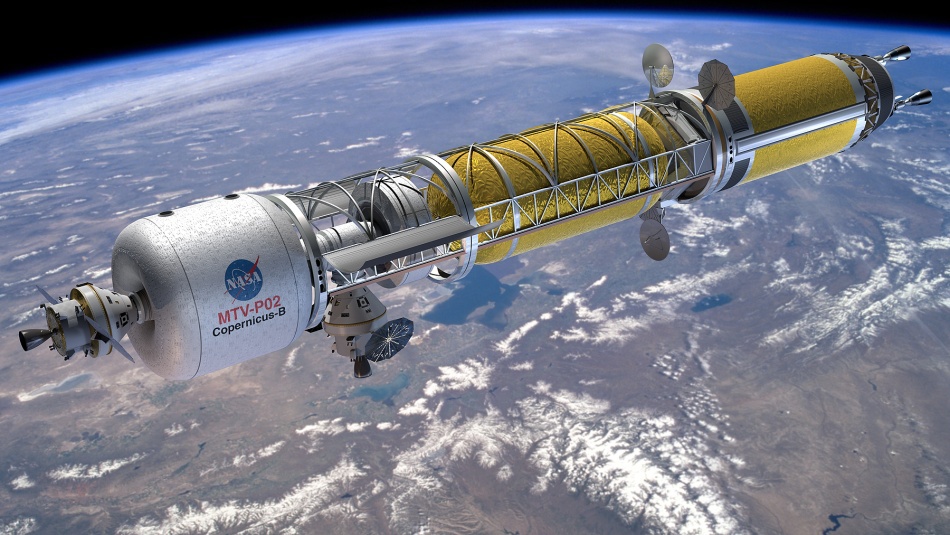
The idea of throwing atomic bombs in the Orion project was too brutal, but the amounts of energy produced by nuclear fission, not to mention the synthesis, are extremely attractive for astronautics. Therefore, a multitude of non-pulse systems were created, free from problems with the storage of hundreds of nuclear bombs on board and cyclopean shock absorbers. We will talk about them today.
Nuclear physics on fingers
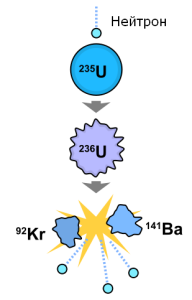
What is a nuclear reaction? If it is very simple to explain, the picture will be approximately as follows. From the school curriculum, we remember that a substance consists of molecules, a molecule from atoms, and atoms from protons, electrons and neutrons (there are levels lower, but this is enough for us). Some heavy atoms have an interesting property — if a neutron hits them, they break up into lighter atoms and release several neutrons. If these released neutrons fall into the nearby other heavy atoms, the decay will repeat, and we will get a nuclear chain reaction. The movement of neutrons at high speed means that this movement turns into heat when neutrons slow down. Therefore, a nuclear reactor is a very powerful heater. They can boil the water, get the steam sent to the turbine, and get a nuclear power plant. And you can heat the hydrogen and throw it out, getting a nuclear jet engine. From this idea were born the first engines - NERVA and RD-0410.
NERVA
Project history
The formal authorship (patent) for the invention of the atomic rocket engine belongs to Richard Feynman, according to his own memoir, “You are, of course, joking, Mr. Feynman.” The book, by the way, is strongly recommended to read. The Los Alamos laboratory began developing nuclear rocket engines in 1952. In 1955, the project was launched Rover. At the first stage of the project, KIWI, 8 experimental reactors were built and from 1959 to 1964 the working fluid was blown through the reactor core. For time binding, the Orion project existed from 1958 to 1965. Rover had the second and third stages, which studied higher power reactors, but NERVA was based on Kiwi because of plans for a first test launch in space in 1964. The timing gradually moved out, and the first ground launch of the NERVA NRX / EST (EST - Engine System Test - engine test) engine took place in 1966. The engine has successfully worked for two hours, of which 28 minutes was work at full thrust. The second NERVA XE engine was launched 28 times and worked for a total of 115 minutes. The engine was recognized as suitable for space technology, and the test setup was ready for testing new assembled engines. It seemed that NERVA had a bright future - a flight to Mars in 1978, a permanent base on the Moon in 1981, orbital tugs. But the success of the project caused a panic in Congress - the lunar program was very expensive for the United States, the Martian program would have been even more expensive. In 1969 and 1970, space funding was seriously reduced - Apollos -18.19 and 20 were canceled, and no one would allocate huge amounts of money to the Martian program. As a result, the work on the project was carried out without serious money support and as a result it was closed in 1972.
Design
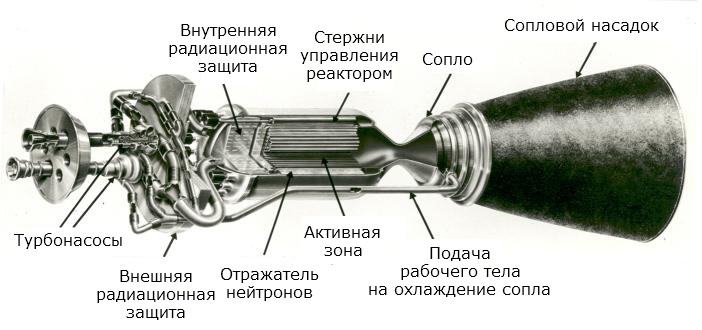
')
The hydrogen from the tank entered the reactor, heated there, and was thrown out, creating jet thrust. Hydrogen was chosen as a working body because it has light atoms, and it is easier to accelerate them to high speed. The greater the speed of the jet exhaust - the more effective the rocket engine.
The neutron reflector was used to return the neutrons back to the reactor to maintain the nuclear chain reaction.
Control rods were used to control the reactor. Each such rod consisted of two halves — a reflector and a neutron absorber. When the rod was rotated with a neutron reflector, their flow in the reactor increased and the reactor increased heat transfer. When the rod was rotated by a neutron absorber, their flow in the reactor decreased, and the reactor lowered heat transfer.
Hydrogen was also used to cool the nozzle, and warm hydrogen from the nozzle cooling system rotated the turbopump to supply new portions of hydrogen.

Engine in work. Hydrogen was set on fire specially at the exit of the nozzle in order to avoid the threat of an explosion; there would be no burning in space.
The NERVA engine produced 34 tons of thrust, about one and a half times smaller than the J-2 engine, which was in the second and third stages of the Saturn-V rocket. The specific impulse was 800-900 seconds, which was twice the number of the best engines on the oxygen-hydrogen fuel pair, but less than the electric propulsion or Orion engine.
Little about security
A newly assembled and not running nuclear reactor with new, not yet working fuel assemblies is clean enough. Uranium is poisonous, therefore it is necessary to work with gloves, but no more. No remote manipulators, lead walls and other things are needed. All emitting dirt appears after the launch of the reactor due to the scattering of neutrons, "spoiling" the atoms of the body, the coolant, etc. Therefore, in the event of an accident with a rocket with such an engine, radiation contamination of the atmosphere and surface would be small, and of course, there would be much less of Orion’s standard launch. In the case of a successful start, the infection would be minimal or absent altogether, because the engine would have to start in the upper atmosphere or already in space.
RD-0410
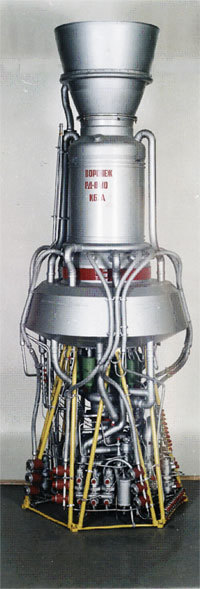
Soviet engine RD-0410 has a similar history. The idea of the engine was born in the late 40s among the pioneers of rocket and nuclear technology. As in the Rover project, the initial idea was an atomic air-jet engine for the first stage of a ballistic missile, then the development was transferred to the space industry. RD-0410 was developed more slowly, domestic developers got carried away with the idea of a gas-phase NRE (this will be discussed below). The project was launched in 1966 and lasted until the mid-80s. The Mars-94 mission, a manned flight to Mars in 1994, was called the target for the engine.
RD-0410 scheme is similar to NERVA - hydrogen passes through a nozzle and reflectors, cooling them, is fed into the reactor core, is heated there and ejected.
According to its characteristics, the RD-0410 was better than NERVA - the core temperature of the reactor was 3000 K instead of 2000 K for NERVA, and the specific impulse exceeded 900 s. The RD-0410 was lighter and more compact than the NERVA and developed ten times less thrust.
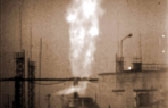
Tests engine. The side flare at the bottom left burns hydrogen to avoid an explosion.
The development of solid-state NRE
We remember that the higher the temperature in the reactor, the greater the flow rate of the working fluid and the higher the specific impulse of the engine. What prevents to increase the temperature in NERVA or RD-0410? The fact is that in both engines fuel elements are in a solid state. If you raise the temperature, they melt and fly out with hydrogen. Therefore, for higher temperatures, it is necessary to come up with some other way to carry out a nuclear chain reaction.
Engine on the salts of nuclear fuel
In nuclear physics, there is such a thing as a critical mass. Remember the nuclear chain reaction at the beginning of the post. If the fissile atoms are very close to each other (for example, they are compressed by pressure from a special explosion), then an atomic explosion will result - a lot of heat in a very short time. If atoms are not compressed so tightly, but the flux of new neutrons from fission increases, a thermal explosion will result. Conventional reactor in such conditions fail. Now imagine that we take an aqueous solution of fissile material (for example, uranium salts) and feed them continuously into the combustion chamber, providing there is a mass more critical. The result will be a continuously burning nuclear “candle”, the heat from which accelerates the reacted nuclear fuel and water.

The idea was proposed in 1991 by Robert Zubrin and, according to various calculations, promises a specific impulse from 1300 to 6700 with a thrust measured in tons. Unfortunately, this scheme has drawbacks:
- The difficulty of storing fuel - it is necessary to avoid a chain reaction in the tank, placing the fuel, for example, in thin tubes from a neutron absorber, so the tanks will be difficult, heavy and expensive.
- Large consumption of nuclear fuel - the fact is that the efficiency of the reaction (the number of decayed / number of atoms spent) will be very low. Even in an atomic bomb, the fissile material “burns out” incompletely, and immediately most of the valuable nuclear fuel will be wasted.
- Ground tests are almost impossible - the exhaust of such an engine will be very dirty, even dirtier than the Orion.
- There are some questions about the control of a nuclear reaction - not the fact that a simple in the verbal description scheme will be easy in technical implementation.
Gas phase YARD
The next idea - what if we create a vortex of the working body, in the center of which there will be a nuclear reaction? In this case, the high temperature of the active zone will not reach the walls, being absorbed by the working fluid, and it can be raised to tens of thousands of degrees. Thus, the idea of an open-cycle gas phase YARD was born:
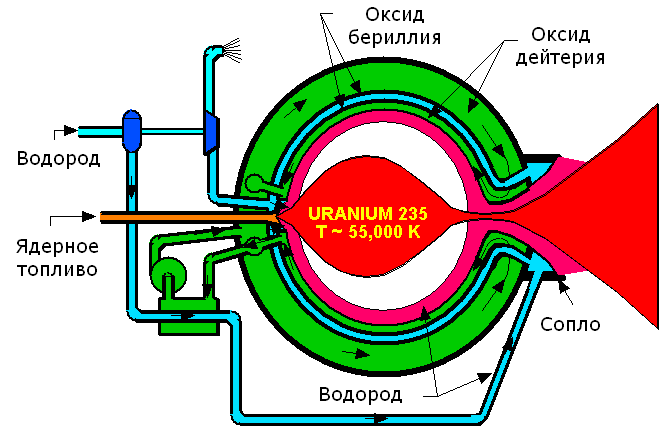
Gas phase YARD promises a specific impulse up to 3000-5000 seconds. In the USSR, a gas-phase YARD project (RD-600) was launched, but it did not even reach the stage of the layout.
"Open cycle" means that nuclear fuel will be thrown out, which, of course, reduces efficiency. Therefore, the following idea was invented, dialectically returning to solid-state NREs - let's surround the nuclear reaction area with a sufficiently heat-resistant substance that will transmit the radiated heat. Quartz was proposed as such a substance, because at tens of thousands of degrees heat is transferred by radiation and the material of the container must be transparent. The result was a gas-phase closed-cycle YARD, or a “nuclear light”:
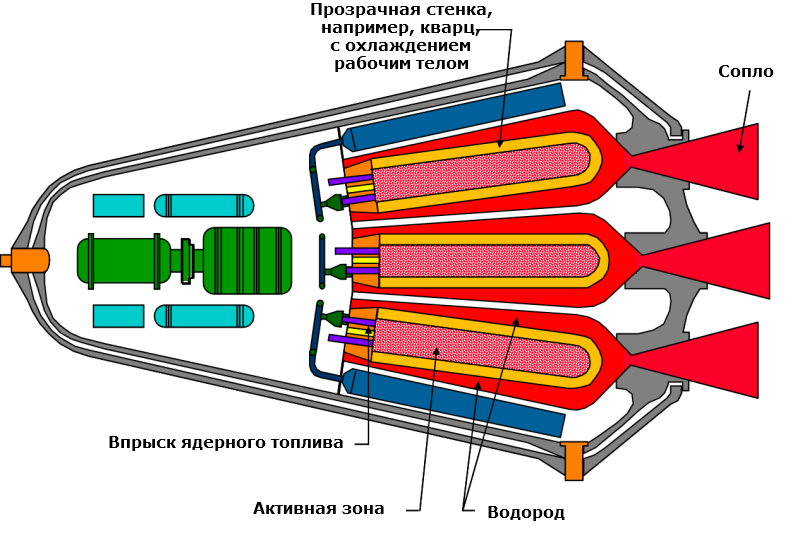
In this case, the limitation for the temperature of the core will be the thermal strength of the “light bulb” shell. The melting point of quartz is 1700 degrees Celsius, with active cooling, the temperature can be raised, but, in any case, the specific impulse will be lower than the open circuit (1300-1500 s), but nuclear fuel will be spent more economically and the exhaust will be cleaner.
Alternative projects
In addition to the development of solid-phase NRE, there are original projects.
Fissile Engine
The idea of this engine is the absence of a working body - it is the emitted spent nuclear fuel. In the first case, subcritical discs are made of fissile materials that do not trigger a chain reaction by themselves. But if the disk is placed in a reactor zone with neutron reflectors, a chain reaction will start. And the rotation of the disk and the absence of the working fluid will lead to the fact that the disintegrated high-energy atoms will fly away to the nozzle, generating cravings, and not decaying atoms will remain on the disk and get a chance at the next disk rotation:
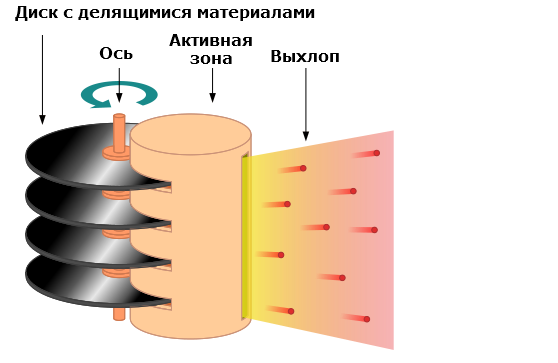
An even more interesting idea is to create a dusty plasma (recall the "plasma crystal" on the ISS) from fissile materials in which the decay products of nuclear fuel nanoparticles are ionized by an electric field and thrown out, creating cravings:

They promise a fantastic specific impulse of 1,000,000 seconds. Enthusiasm cools the fact that the development is at the level of theoretical research.
Nuclear fusion engines
In an even more distant future, the creation of nuclear fusion engines. Unlike nuclear disintegration reactions, where atomic reactors were created almost simultaneously with a bomb, thermonuclear reactors have not yet moved from tomorrow to today and fusion reactions can only be used in the Orion style - rushing to thermonuclear bombs.
Nuclear photon rocket
Theoretically, you can heat the active zone to such an extent that the craving can be created by reflecting photons. Despite the lack of technical limitations, such engines are unprofitable at the current technology level - the thrust will be too small.
Radioisotope rocket
The rocket heating the working fluid from the RTG will be quite working. But RTGs produce relatively little heat, so this engine will be very inefficient, although very simple.
Conclusion
At the current level of technology, you can assemble a solid-state YARD in the style of NERVA or RD-0410 - the technology has been mastered. But such an engine will play a bunch of "nuclear reactor + electric propulsion" by specific impulse, winning by the burden. And more advanced options are still only on paper. Therefore, personally, the “reactor + electric propulsion” cluster seems to me more promising.
Information sources
The main source of information is English Wikipedia and the resources listed in it as links. Paradoxical as it may seem, there are some curious articles about YARD on the Tradition - solid - phase YARD and gas-phase NRE . An article about engines on fissionable fragments and dusty plasma .
Source: https://habr.com/ru/post/227973/
All Articles